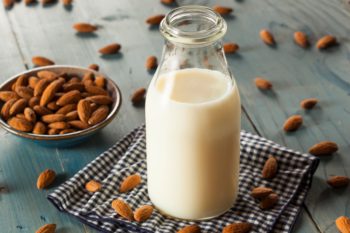Choose a milk alternative according to what you want to use it for – they all have different flavours, so it’s a good idea to try a few to see which one you prefer.
Like more than one? Mixing and matching your non-dairy milks is a good way to ensure you get as many varied nutrients as possible.

Pictures: iStock.
Soya
Why use it? To help lower cholesterol and reduce menopausal symptoms – women in countries that eat lots of soya have fewer hot flushes and a lower risk of breast cancer. It’s high in protein, calcium, mono/polyunsaturated fats, and low in saturated fats.
Why not? Non-organic varieties may be genetically modified. May be sweetened with sugar and high in salt. Unsuitable if you’re one of the five per cent of people allergic to soya.
Tastes like? Slightly creamy and nutty – you tend to either love or loathe it.
KJ per 100ml: 103
Goat
Why use it? A good source of calcium and is more easily digestible than cows’ milk. It has lower levels of lactose and alpha S1-casein, thought to be responsible for cows’ milk allergy. Less likely to cause IBS-type symptoms, asthma and rashes, if those have been a problem.
Why not? Lower levels of B vitamins and zinc than cows’ milk. Some proteins are similar to cows’ milk, so don’t switch without expert advice if you are allergic.
Tastes like? Like a slightly stronger cows’ milk. Can be an acquired taste.
KJ per 100ml: 126 (skimmed); 185 (semi-skimmed); 297 (full fat)
Coconut

Why use it? It contains medium chain fatty acids (MCFAs) – types of saturated fatty acids that are easier to digest and have a better health profile than other saturated fatty acids. This type of coconut milk is not the same as the canned varieties used to make curries.
Why not? May be sweetened with sugar and have added salt and other additives.
Tastes like? Similar to skimmed milk with the slightest hint of coconut.
KJ per 100ml: 1517
Rice
Why use it? It’s less likely to cause allergies than cows’ milk or soya. Its naturally sweet taste may be preferable to soya. Go for calcium-enriched varieties.
Why not? More watery and thinner than soya milk. Also high in carbs and may have added sugar.
Tastes like? Slightly sweet. Good on cereal but you may find it too sweet and watery in tea and coffee.
KJ per 100ml: 260
Almond

Why use it? For weight loss – it has more protein than grain-based milks, such as rice or oat (although less than cows’ milk), so helps keep you satisfied longer.
Why not? May contain added sugar or agave syrup, which some people find causes wind. It may also contain salt and food additives. Unsuitable for those with a nut allergy.
Tastes like? Sweetish and almondy – good over cereal and in pancakes, mashes and cakes, but can curdle in tea and coffee.
KJ per 100ml: 148
Quinoa
Why use it? It has the same protein quality as milk which makes it a great substitute. The quinoa grain is low in cholestoral, sodium and saturated fats. It’s also high in all the heart-healthy fats such as omega-3 fatty acid and monounsaturated fats.
Why not? The grain doesn’t have a popular taste and some people either love it or hate it. Quinoa milk is not a good choice for those on a milk-free diet.
Tastes like? A sweet, creamy taste. Great for coffee, breakfast cereal and smoothies.
KJ per 100ml: 265
Oat
Why use it? To help lower cholesterol and reduce menopausal symptoms – women in countries that eat lots of soya have fewer hot flushes and a lower risk of breast cancer. It’s high in protein, calcium, mono/polyunsaturated
Why not? Non-organic varieties may be genetically modified. May be sweetened with sugar and high in salt.
Tastes like? Slightly creamy and nutty – you tend to either love or loathe it.
KJ per 100ml: 103
Looking for dairy-free food swaps? Look no further than this helpful list.
If you want to go dairy free, but aren’t sure where to start, sign up to our #7Days #FreeFrom dairy newsletter. For one week, we’ll send you all the recipes, tips and inspiration you need. Sign up for free here.
DISCLAIMER: Before starting any diet, you should speak to your doctor. You must not rely on the information on this website/newsletter as an alternative to medical advice from your doctor or other professional healthcare provider.
